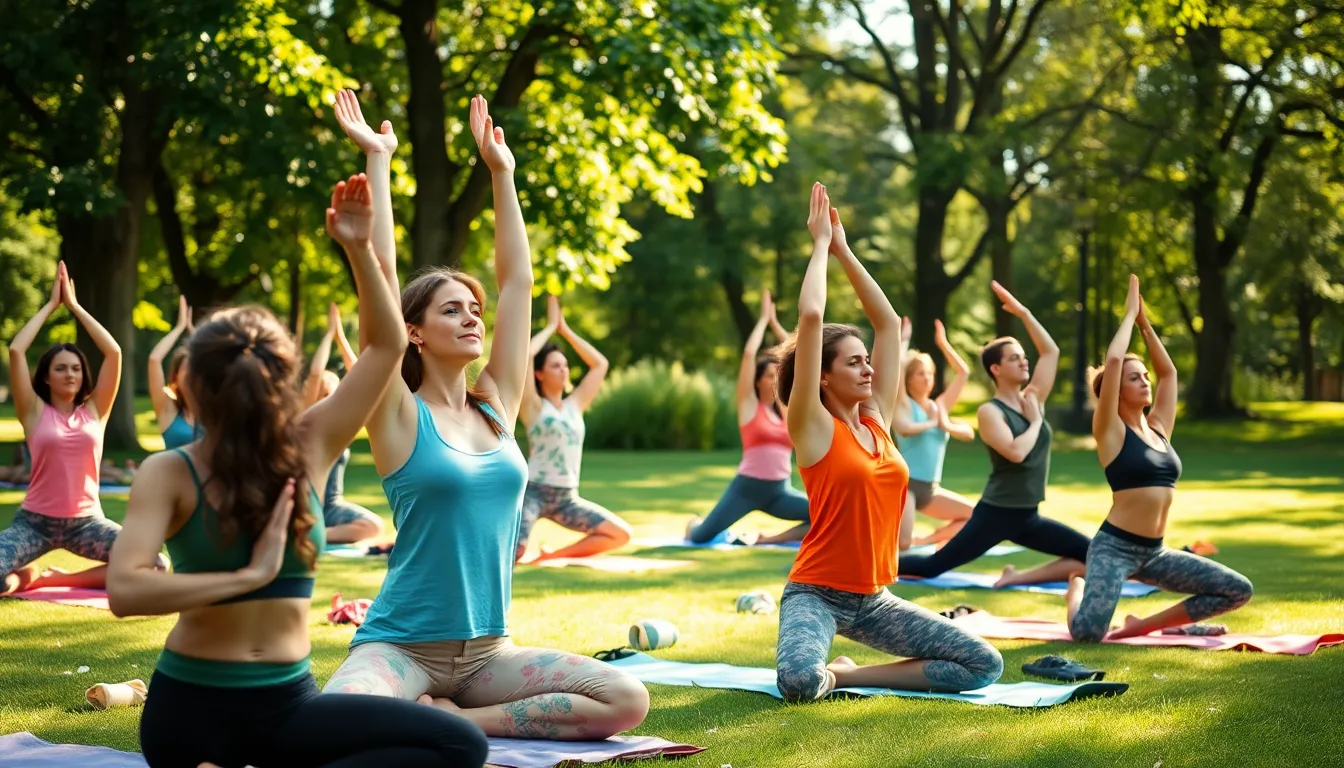In today’s fast-paced world, it’s easy to get lost in the chaos of daily life. Enter mindful exercise—a practice that not only gets the heart pumping but also invites a little zen into the mix. Imagine combining the sweat of a workout with the tranquility of meditation. Sounds like a match made in fitness heaven, right?
Mindful exercise isn’t just about breaking a sweat; it’s about tuning in to the body and mind. Whether it’s yoga, tai chi, or even a brisk walk while paying attention to each breath, this approach helps folks reconnect with themselves. So why not ditch the mindless treadmill routine and embrace a workout that nourishes both body and spirit? After all, who wouldn’t want to feel fit and fabulous while finding their inner peace?
Table of Contents
ToggleWhat Is Mindful Exercise?
Mindful exercise integrates physical activity with mindfulness practices, fostering a connection between body and mind. This approach emphasizes awareness and presence during workouts, encouraging individuals to engage fully in their movement.
Definition and Key Concepts
Mindful exercise refers to any physical activity performed with heightened awareness. Practitioners focus on their breath, body sensations, and the environment. Key concepts include presence, awareness, and intentional movement. Mindful exercises, like yoga and tai chi, offer structured practices that enhance self-awareness. Additionally, activities such as mindful walking promote attention to each step, improving overall experience. Establishing this connection can lead to better exercise outcomes and deeper relaxation.
Benefits of Mindful Exercise
Mindful exercise promotes various physical and mental health benefits. Engaging in mindful practices can reduce stress levels and enhance mood. Individuals often experience improved focus and concentration. Lowering anxiety is another advantage, as increased mindfulness helps in managing everyday stresses. Enhanced flexibility and balance result from activities like yoga and tai chi. Regular practice can lead to a greater sense of well-being, encouraging consistent participation in physical activity. Overall, mindful exercise nurtures both the body and the mind, creating an environment for holistic health.
Types of Mindful Exercise

Mindful exercise includes various practices that enhance both physical fitness and mental clarity. Here are a few notable types of mindful exercise.
Yoga and Its Variations
Yoga encompasses numerous styles, including Hatha, Vinyasa, and Kundalini. Each style offers unique benefits and focuses on breath control, alignment, and meditation. Practitioners cultivate awareness of their body and mind through asanas, or postures, while transitioning between movements. This approach promotes flexibility, strength, and relaxation. Classes often include guided meditations or affirmations, reinforcing the mental aspect of practice. Engaging in yoga enhances body awareness and fosters a deeper connection to oneself.
Tai Chi and Qigong
Tai Chi is a traditional Chinese martial art characterized by slow movements and deep breathing. This practice enhances balance, flexibility, and muscle strength, while reducing stress. Qigong, closely related to Tai Chi, involves gentle movements, meditation, and breath regulation. Both exercises emphasize the flow of energy, or Qi, throughout the body. Practitioners find tranquility by synchronizing movements with their breath and focusing on the present moment. Regular engagement in Tai Chi and Qigong improves overall well-being and encourages mindfulness in daily activities.
Walking Meditation
Walking meditation melds movement with mindfulness by focusing on each step taken. The practice encourages individuals to pay attention to their feet, breath, and surroundings while strolling. Walking becomes a deliberate activity that promotes relaxation and reduces anxiety. Participants often practice in tranquil environments like parks or gardens, adding to the meditative experience. A heightened sense of awareness develops as walkers notice textures, sounds, and scents. This simple yet powerful form of mindful exercise fosters a deeper appreciation for the moment.
How to Practice Mindful Exercise
Practicing mindful exercise enhances both physical activity and mental well-being. Several techniques and routines help individuals engage with their bodies and minds.
Techniques for Beginners
Starting mindful exercise requires simple techniques. Focus on breath as the initial step. Inhale deeply through the nose and exhale gently through the mouth. Gradually incorporate body awareness by noticing sensations during movement. Beginners can practice yoga or tai chi, as these disciplines emphasize intentionality. Engage in mindful walking by concentrating on each step and the rhythm of breathing. Use a quiet environment to minimize distractions. Regularly checking in with feelings and thoughts reinforces mindfulness practice.
Creating a Mindful Exercise Routine
Establishing a mindful exercise routine involves consistency and variation. Choose a specific time each day for practice, creating a habit. Begin with short sessions, ranging from 10 to 20 minutes, and gradually increase duration. Include different forms of exercise, such as yoga, tai chi, and walking meditation, to balance physical and mental engagement. Prioritize a comfortable space free of interruptions. Set realistic goals focusing on improvement rather than perfection. Record progress and feelings to enhance self-awareness over time. This structured approach promotes lasting benefits for both body and mind.
Mindful Exercise in Daily Life
Mindful exercise can seamlessly fit into everyday routines, enhancing physical fitness and mental clarity. Integrating mindfulness into workouts creates a deeper connection with the body and improves overall well-being.
Integrating Mindfulness into Workouts
Incorporating mindfulness into workouts enhances focus and body awareness. Practitioners can start by concentrating on their breath while engaging in various exercises. Focusing attention on each movement helps foster a sense of presence. For instance, during yoga, paying attention to the alignment of the body amplifies the experience. Emphasizing feelings of tension or relaxation within muscles promotes a greater understanding of physical limits and capabilities. Regularly implementing these techniques during workouts enriches the overall experience and cultivates a more mindful approach to fitness.
Mindful Exercise for Stress Relief
Mindful exercise effectively reduces stress and promotes relaxation. Engaging in practices like tai chi or yoga encourages individuals to center themselves in the present moment. Observing bodily sensations and breathing patterns alleviates mental strain. Regular practice leads to a heightened awareness of stress triggers, allowing for better management. Participants often notice improvements in mood and an increased ability to cope with daily pressures. Creating a routine that incorporates mindful walking or meditation can further enhance relaxation and provide a necessary escape from life’s demands.
Embracing mindful exercise can profoundly impact one’s overall well-being. By integrating awareness with physical activity, individuals can cultivate a deeper connection to their bodies and minds. This practice not only enhances fitness but also fosters mental clarity and emotional resilience.
Incorporating mindful exercises like yoga, tai chi, or mindful walking into daily routines offers a pathway to reduced stress and improved mood. With consistent practice, individuals can experience the benefits of heightened self-awareness and intentional movement.
Ultimately, making mindful exercise a priority paves the way for a balanced lifestyle that nurtures both physical health and inner peace.





